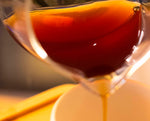When I think about coffee, the first thing that comes to my mind is its aroma: The delicious smell that comes out when I’m grinding coffee or brewing it. It connects me directly to my senses, bringing comfort and nice feelings. That’s nothing better than starting the day with a fresh cup of coffee. The Specialty Coffee experience is all about flavour and what it takes to have the most stunning coffees. But what makes the coffee flavour?
Flavour is a combination of aroma and taste. We feel it in our tongue, in our olfactory bulb, and nasal cavity. On the tongue, we perceive the basic tastes - acid, sweet, bitter, salty and umami (savoury). If we pay attention to what we are experiencing when we drink a sip of coffee, we start to notice general flavours like fruity, floral, chocolaty, nutty. With experience, we refine our senses and are able to taste and experience more. Just as wine, coffee tasting brings us a complex flavour experience.
Before we drink a delicious cup of coffee, there are many factors that have an influence on its final flavour. Let’s explore what that is:


It Starts at The Farm
The coffee bean is the seed of a fruit. With that in mind, it tastes at its best when it is fresh in season. As an agricultural product, all the work made on the farm matters and has an impact on the coffee flavour. The coffee trees grow in the tropics, between the Tropic of Capricorn and the Tropic of Cancer, all over the world. There are two main coffee varieties - Arabica and Robusta. Arabica is considered the best tasting one. It grows in higher altitudes and has more acidity and flavour nuances. Arabica has different varietals, like Typica, Bourbon, Catuai, and each one has different taste profiles. Single origin coffees are traceable. The varietal and the region where the coffee comes from are normally indicated on the package of Specialty Coffees.
The soil where the coffee grows also matters. Just as in the wine industry, we relate to it as terroir. Mineral-rich soils as clay or volcanic are better because they provide more nutrients to the plant. The climate and the altitude play an important role too. Adequate weather conditions lead to the right maturation of the cherries and therefore to a more structured flavour in the cup. Due to these environmental conditions, different regions produce unique taste profiles. For instance, coffee in Ethiopia is known for its floral notes, while the Colombian ones are nuttier, and Kenyan ones are fruity. Of course, these are just general profiles. Each region in the same country has singular climate conditions that lead to unparalleled flavours.
The largest impact on flavour comes from processing. Dry processing, known as natural, is the oldest method. The coffee beans are dried in the sun with the whole cherry. Some producers spread the cherries on brick patios. Others use raised drying beds, which allows the air to circulate more and leads to an even drying. The coffee must be turned regularly to avoid mould and fermentation, which would make it taste unpleasant. The natural process adds some flavours to the beans, mainly fruity ones. The sweetness of the cherries also remains in the beans, resulting in a sweeter coffee.
In opposition to this process, there is the washed one, in which the cherries are soaked in water and entirely removed before the drying period. This process usually leads to a cleaner taste with a bright acidity. Without having the whole cherries around, the beans dry easier. It is, though, a more expensive method, which requires large amounts of water.






